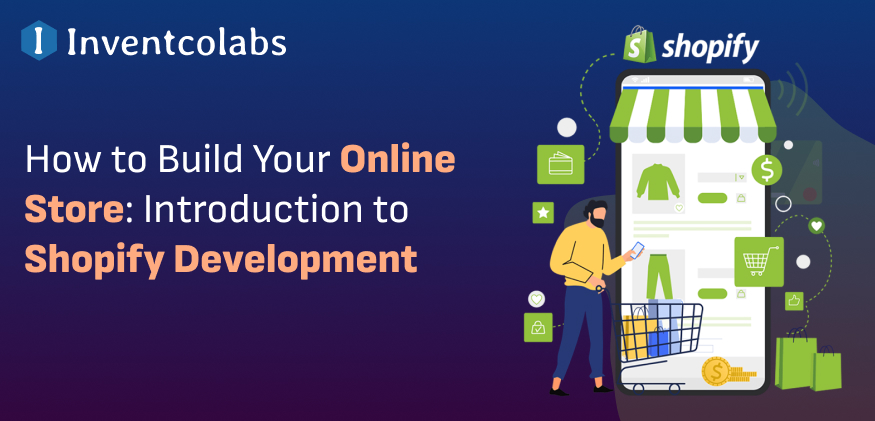Creating an effective online presence isn’t merely a matter of choice in today’s rapidly changing market. It’s an imperative requirement for companies of all sizes. The digital world is the gateway to a large and diverse market, allowing companies to reap various benefits. One of the main reasons is the immense reach provided by a presence on the internet. A well-designed website or a well-planned existence on social networks could increase a company’s influence beyond borders, tapping into markets previously considered out of reach.
Consider giants such as Amazon and Alibaba as examples. They have used platforms on the internet to cross physical borders and connect with people worldwide. Additionally, the internet lets businesses create targeted marketing campaigns, adjusting content to specific groups of people and increasing the chances of reaching prospective customers. With consumers increasingly turning to websites for transactions and information, having a strong presence on the internet isn’t just beneficial but essential for companies seeking to sustain expansion and be relevant in the digital age.
The process of creating websites has never been simpler. Website builders make developing websites reflect your company’s image easy. They also offer business tools, such as online checkout and shipping services, and marketing tools, including the search engine optimizer (SEO).
Shopify Development: What Is It?
Making an online store with an online store using the Shopify platform is referred to by the name of Shopify development. It is an online marketplace that is easy to use and provides various amazing options for businesses. With the help of Shopify’s site Shopify, it is possible to create an online business even when you do not have any experience in programming.
With Shopify development, you can alter the look and functions of your store. Choose a theme, add products, and then arrange for payment and shipping. You can also add third-party apps and services to your store.
When developing Shopify designs, they use the resources and tools Shopify provides to modify the store’s appearance and its functionalities. They can choose intricate designs, arrange items efficiently, and create customer payment options.
Using Shopify development services, you can easily create a functional and visually appealing online store. It’s a fun and unique way to grow an online business! Through Shopify advancement, you can build a customer base across the globe through product sales.
Explore More: Top 12 Easy Steps to Build an Online Shopping App
Reasons to Use Shopify for Online eCommerce Store Development
In addition to having all the features merchants require to run the Shopify eCommerce website, the eCommerce platform also supports expanding and expanding companies.
Let’s dig deeper to find out the most compelling reasons that could suggest that selecting Shopify is a smart choice:
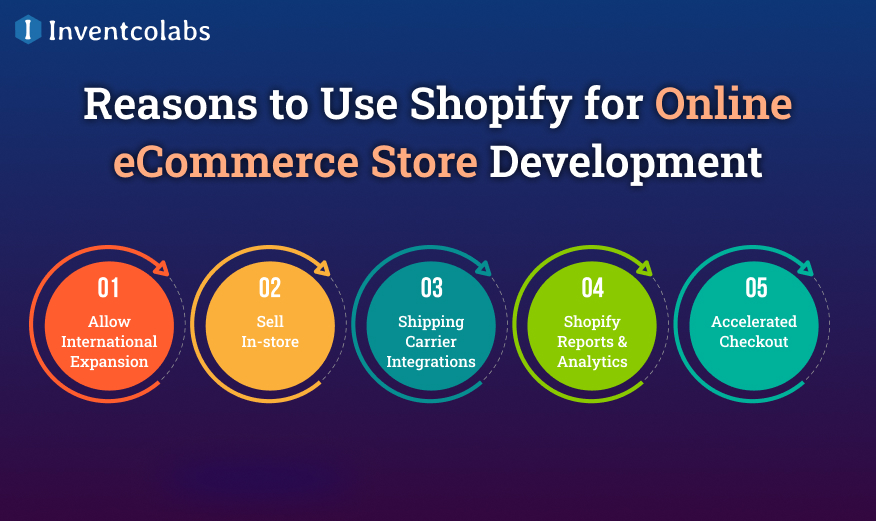
>Allow International Expansion
Shopify Markets, an application for managing cross-borders created by Shopify, helps create personalized online shopping experiences targeted at specific areas or countries, which can reduce expansion efforts.
>Sell In-store
By using Shopify POS, businesses can sell in-person through pop-ups or brick-and-mortar. It comes with full hardware, payment gateways, and applications, which ensures a perfect connection between customer information, inventory, and sales.
>Shipping Carrier Integrations
With Shopify, you will receive pre-integrated connections to shipping companies, which send direct notifications to your customers, including time estimates and orders out for delivery. This results in better customer service.
>Shopify Reports & Analytics
The choice to go with Shopify eCommerce store development lets you benefit from Shopify reporting, which gives merchants information about their business. Furthermore, these reports are organized into clear categories for more efficient analysis.
>Accelerated Checkout
One of the leading eCommerce platforms known for its speed and performance is Shopify’s checkout. This offers express checkouts that can conserve shipping details and customers’ payment details. So, customers who have returned to Shopify can quickly pay for their purchases.
Explore More: How Much Does It Cost to Build a Prescription Discount App like GoodRx?
Key Features of Shopify Development
Shopify is praised for its extensive features that enable companies to easily build, manage, and expand their online stores.
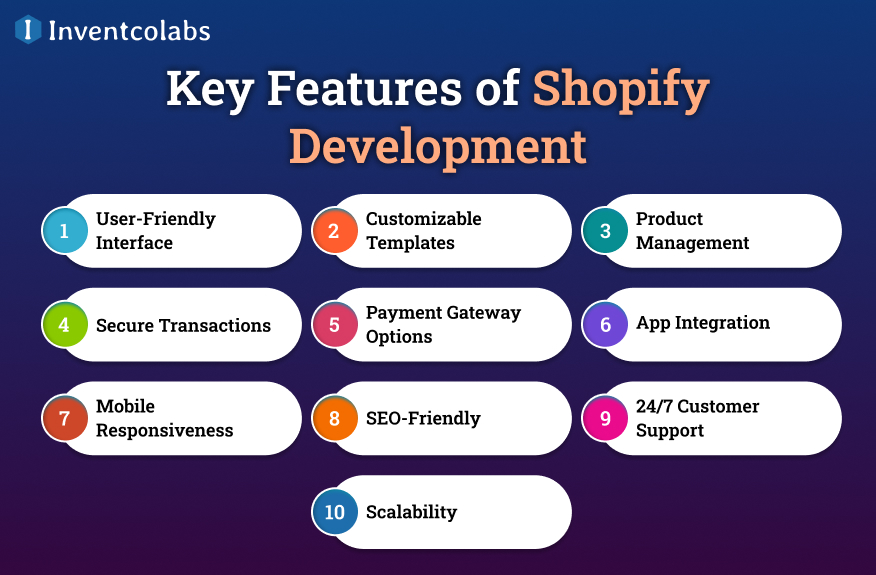
>User-Friendly Interface
Shopify’s intuitive interface makes it accessible to people with different levels of technical proficiency. It is designed to simplify the procedure of setting up and running an online store while ensuring the smoothest user experience.
>Customizable Templates
With a wide range of customizable templates, Shopify allows businesses to create a distinctive and appealing brand identity. Customers can alter these templates with an in-built theme editor. You can also go deeper into customization with the Liquid programming language.
>Product Management
Shopify helps manage products with an easy-to-use interface for adding edits and organizing product listings. It also includes features for different product types and inventory tracking. It can display items with high-quality photos and detailed descriptions.
>Secure Transactions
Security is Shopify’s top priority. It ensures safe online transactions for businesses and customers. Shopify is equipped with SSL encryption to safeguard sensitive information and create confidence and trust in your purchasing experience.
>Payment Gateway Options
Shopify provides a range of payment options, allowing businesses to offer their customers a variety of payment choices. From credit cards to digital wallets, Shopify allows smooth and secure transactions that address a range of customers’ preferences.
>App Integration
Shopify’s App Store offers a large collection of third-party applications that can be seamlessly connected to the Shopify platform. The apps offer a range of capabilities, such as marketing analytics, customer support, and inventory management, which allows businesses to customize their online stores to suit specific requirements.
>Mobile Responsiveness
Recognizing the rising mobile shopping trend, Shopify ensures that its online store is mobile-friendly. This feature optimizes the shopping experience for shoppers across different devices, leading to a wider audience and improved user engagement.
>SEO-Friendly
Shopify integrates SEO with best practices, making it much easier for businesses to optimize their online store for search engines. This includes customizable tag titles and descriptions, Meta descriptions, and clear URL structures that increase search results visibility.
>24/7 Customer Support
Shopify offers 24-hour support for customers to help them with any difficulties. This dedication to customer support guarantees that companies using Shopify can get prompt help whenever required.
>Scalability
Whether you’re a small startup or an established business, Shopify offers scalability. The platform can grow with companies, accommodating a greater number of product offerings, a greater volume of traffic, and changing business requirements.
Explore More: How Much Does It Cost To Create An App?
Tips for Optimizing Your eCommerce Shopify Store
Okay, let’s talk about creating a way to make your Shopify store stand out in the mobile world. With increasing numbers of people buying from their tablets and smartphones, optimizing for mobile devices is no longer an option; it’s now a requirement. Here are some ways to make sure your Shopify store is visible on mobile devices and entices shoppers on the move.
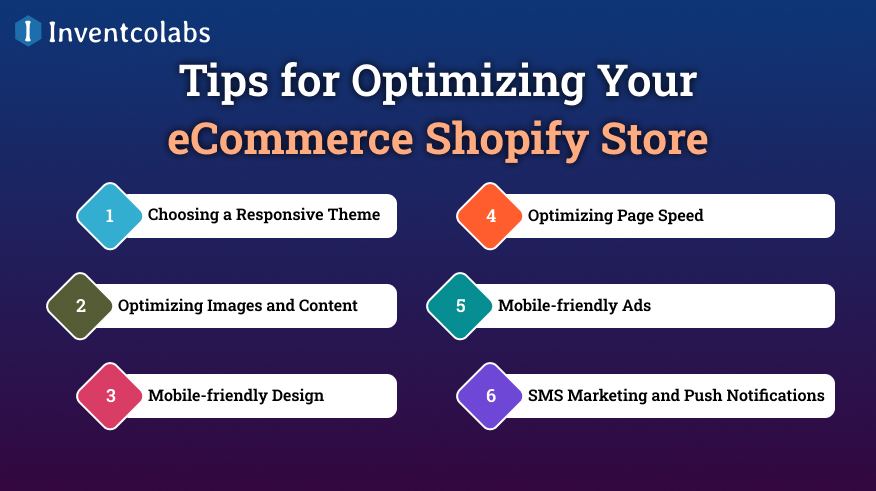
>Choosing a Responsive Theme
First, you must select an adaptive design for your Shopify store. A responsive theme can be easily adjusted to various screen sizes, ensuring users have a seamless and comfortable experience across all devices. This is the basis of a mobile-friendly shop, so make sure you choose the right one.
>Optimizing Images and Content
Next, you must ensure that your content and images are optimized for mobile phones. Use quality images that load quickly and won’t slow down your mobile website. Make sure your content is concise and interesting, using clear calls to action that are simple to click on mobile screens.
>Mobile-friendly Design
Design is a key factor in mobile-friendliness. Make sure your layout is clear, neat, and user-friendly, even on tiny screens. You can also optimize the design of you eCommerce store by hiring a Shopify website development company. Use mobile-friendly fonts and button sizes. You can also reduce the necessity of scrolling or zooming. Nobody wants a crowded mobile experience.
>Optimizing Page Speed
Page speed is paramount, particularly on mobile devices. Make your site more efficient by reducing the size of your images, enabling browser caching, and removing unnecessary plugins and scripts. A site that loads quickly not only improves user experience but also increases your rankings on search engines.
>Mobile-friendly Ads
When it comes to advertising and promotions, you should think mobile-first. Create appealing and responsive advertisements that are specifically designed for mobile devices. Utilize compelling images, clear messages, and clear CTAs to boost conversions from mobile devices.
>SMS Marketing and Push Notifications
Don’t overlook the potential of push and SMS notifications. These direct communication channels allow users to connect with customers immediately and boost engagement. Make customized offers, updates to your products, and abandoned cart reminders so that you can keep your mobile users active and coming back to see more.
If you follow these mobile optimization techniques, you’ll provide an enjoyable and seamless shopping experience for your customers on mobile devices. This will ultimately increase sales and expand your Shopify store’s reach on the mobile market. Keep an eye out for more ways to improve your Shopify store’s performance for maximum success.
Explore More: Developing an Online Store for Selling Auto Parts: A Comprehensive Guide
Steps to Set-Up Your Online Store Using Shopify in 2025
Let’s put on our hoods and begin setting up the online shop. It’s not as difficult as it might seem. We’ll break the process into manageable steps to help you establish the Shopify Store.
>Sign up for a Shopify Account
The initial set-up of a Shopify shop is the simplest part. To get started, all you need to do is create an account.
Visit Shopify.com and click “Start a free trial” in the upper left corner. After that, you must enter your store’s name, password, and email.
Remember that Shopify will not let you buy the domain unless you select a unique name for your shop.
After hitting “next,” you’ll need to click the “next” button and tell Shopify some details about yourself and what you’re selling. After you’re done, select Enter My Store.
>Configure Your Shopify Website
The menu on the left links all Shopify features and tools, such as orders, products, and customers. This menu will be available when you go to your store.
The bottom left has a setting button. You can also alter the time zone, currency, and shop title.
>Choose a Theme
Your company’s initial theme comes with it when it launches. Click your Online Store link under Sales channels on the left sidebar to start installing a new theme.
To view free themes, you could include them in your online store, go to the bottom, and select the free themes. After evaluating the criteria, you can pick the one that best fits your needs.
The following aspects included in the Shopify theme can be modified:
- Typefaces
- Logos
- Palettes of hues
- Features of Associated Products
- Slideshows from the homepage, including a carousel
- Things that are displayed on the web
>Personalize the Shopify Website’s Design
The ability to differentiate your online business is vital to distinguishing it from your competitors and providing the highest level of customer service. Shopify’s design is simpler and makes it easy to use.
You are free to alter the theme in any appropriate way. It’s important not to devote time to achieving a perfect look.
Go back to the online store tab in the left navigation bar. Then, click Customize by moving your mouse over the theme you created.
The left-hand tools let you modify the text, add buttons, upload images, etc. When you adjust your settings on the right, you will see a live preview of how your company will appear.
>Include Goods and Services in Your Shop
Once your website’s design is completed, you can begin listing products and services for sale.
To begin, select the escape symbol in the upper right corner. This will shut down this design editing tool and bring you back to the Shopify admin dashboard.
Simply click the Products link on the left-hand navigation bar to return to the administration panel. Then, you will be taken directly to your Products page. In the center of the page is a button that states, “Add products.”
The moment you select Add Products, a complete page for the initial product is displayed. This page lets you include a description, title, description of the product, price, type images, and other details.
Just rinse and repeat for each service or product after you’ve completed the initial.
>Arrange Your Items
You may offer various products and services, such as training packages, T-shirts, and other accessories—sort products into categories or groups to ensure order.
This is a crucial step because the simpler it is for your customers to discover the information they need, the more likely they are to buy from you.
For the final step, go back to the Shopify administrator page. Select the Collections option by clicking on Products.
Include the collection’s title and any additional information you’d like to include regarding the product groupings. You can set up Shopify to automatically add items that meet certain criteria to the collection.
>Select Your Mode of Payment
The final crucial step is to integrate payment methods into your Shopify website. Go to the Shopify administrator dashboard, select Settings, and then, from the menu bar to the left side, select Payments.
To install Shopify Payments on your site, activate Shopify Payments on this page and follow the simple steps.
The most straightforward option is to click the button to see all other providers beneath the button if you’d prefer to accept payments through PayPal or another source external to PayPal.
Explore More: How To Build A Point Of Sale (POS) System – Complete Guide
>Open Your Shopify Website
Once you’re ready to go live with your online store, click the “Launch” button on your Website.
Best wishes! There is currently an active Shopify website.
You’ve succeeded. Now is the time to see the fruits of your labor after all your efforts. It’s time to begin selling on your website.
Tips to Market Shopify Store in 2025
Once your Shopify store is operational, it’s time to get it before your intended public and start making noise in the digital world. Let’s explore some efficient marketing strategies that can aid you in standing out and drawing attention to your online store.
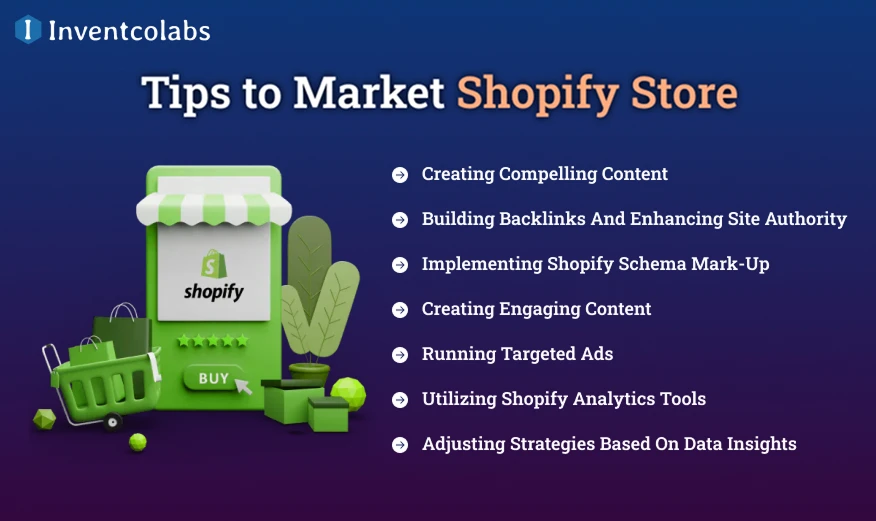
>Creating Compelling Content
Begin by creating informative and engaging material on your blog post or pages for products on the Shopify Store. Offer valuable tips, insights, and guides on how-to that will resonate with your readers and demonstrate your knowledge. Good content not only draws people to your site but also boosts its SEO ranking.
>Building Backlinks and Enhancing Site Authority
Concentrate on building high-quality backlinks to reputable websites within your field. Work with Shopify app development company and guest bloggers on relevant blog sites and participate in forums for industry professionals to increase your website’s authority and credibility. Backlinks play an important role in boosting your site’s ranking on search engines and increasing visitors to the site.
>Implementing Shopify Schema Mark-up
Use Shopify’s Schema mark-up to give search engines organized information regarding your product, reviews, and business information. This assists search engines in comprehending your content and enhancing your search engine visibility, which results in increased organic traffic and better click-through rates.
>Creating Engaging Content
Use social media platforms’ potential to engage with your customers at a deeper level. Create captivating posts, such as stories, videos, and stories that highlight your products and services, provide testimonials from customers, and even offer special discounts. Engage your fans, respond to feedback, and encourage content from users to create a sense of connection to your brand.
>Running Targeted Ads
Utilize social media advertising platforms such as Facebook or Instagram to reach a larger public and draw targeted customers towards the Shopify store. Design attractive ads that specifically target specific demographics and preferences, and track your ads’ results to improve your campaigns for the highest ROI.
>Utilizing Shopify Analytics Tools
Utilizing Shopify’s built-in analytics tools can provide important insights into your store’s performance. Keep track of key metrics such as factors that drive traffic and conversion rates, the average order value, and even customer behaviors. Use this information to determine areas for improvement and make informed decisions based on data to maximize your store’s performance.
>Adjusting Strategies Based on Data Insights
Examine the data collected from Shopify analytics and other marketing channels to refine your strategies. Choose the most effective products, highly effective marketing campaigns, and areas of customer engagement. Modify your marketing strategies, products, offerings, and user experience based on findings to help drive constant expansion and achieve success.
Implementing these strategies and using data-driven insight, you’ll be able to promote your Shopify store successfully by 2025 and even beyond. Continue to experiment, learn, and adapt to keep up with the constantly changing digital world.
Explore More: Developing a Mobile App for Buying and Selling Used Cars- Cost & Features
The Key Takeaway
In the end, establishing an online store with a Shopify store opens many possibilities for turning your passion into a lucrative online business. With its intuitive interface, customization options, integrated payment gateway, and SEO-friendly features, Shopify offers everything you require to succeed in the digital world. Following our step-by-step guide will help you create your Shopify store in no time and make it more effective in 2025 and beyond.
Shopify development company offers a simple and effective way for people and businesses to establish an online presence. With its easy-to-use interface, customizable options, and extensive tools, Shopify empowers users to develop and run profitable online stores.
Whether you’re just starting or an experienced programmer, Shopify offers the tools and resources that will help you bring your eCommerce dream to reality. Start the Shopify journey today and witness the evolution of your business online.
